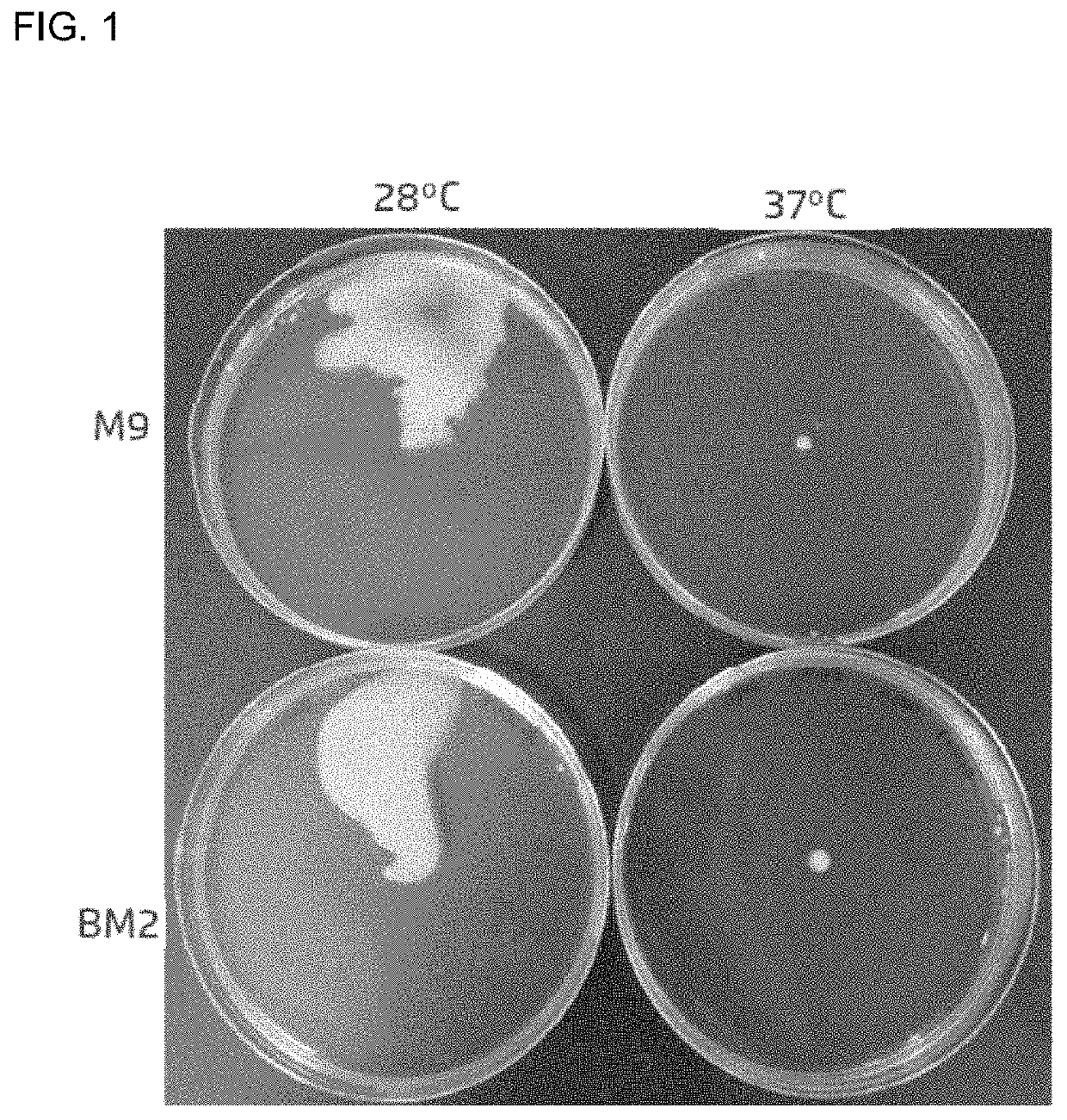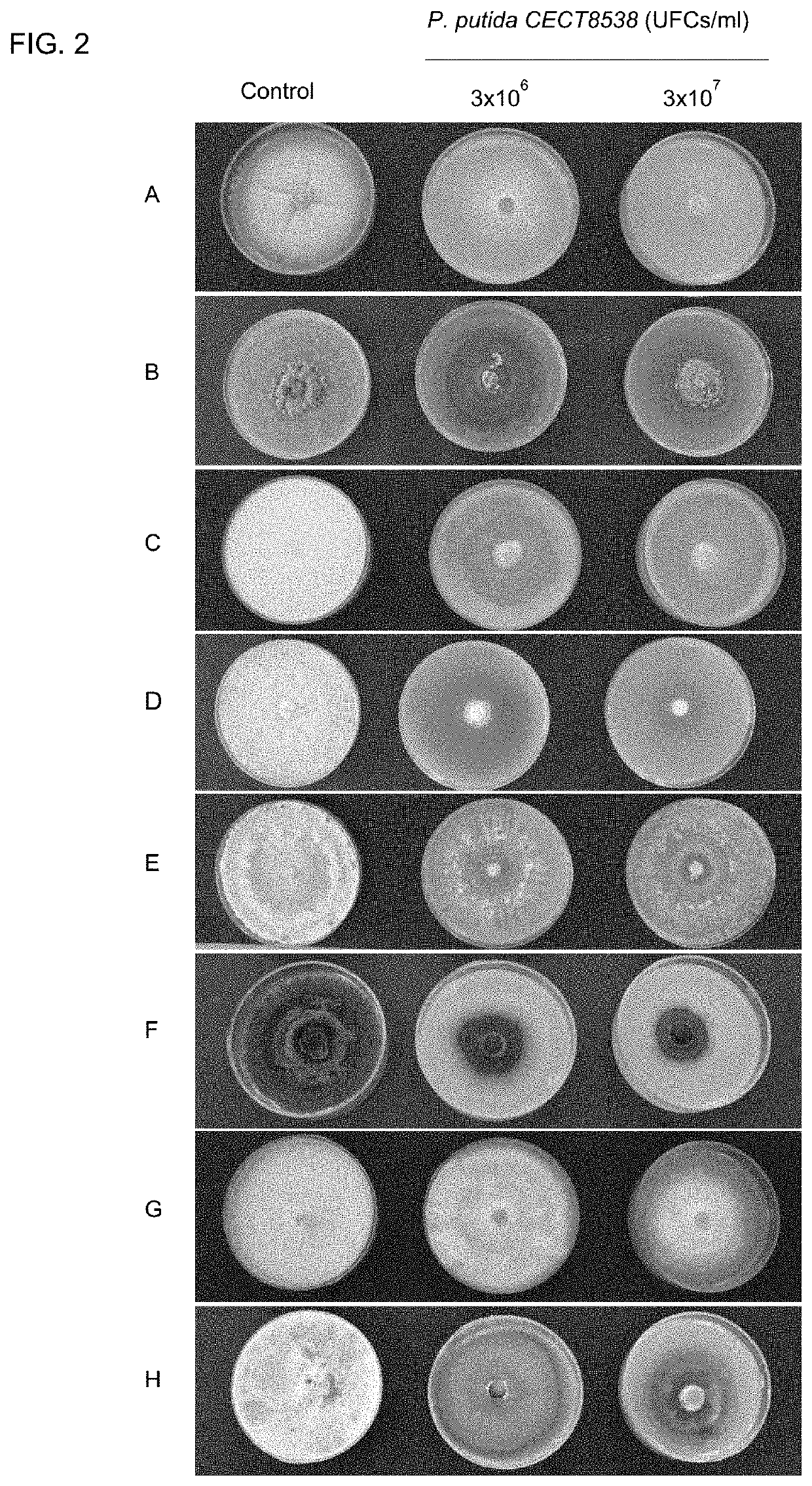Strain of Pseudomonas putida and its use in the control of diseases caused by bacteria and fungi in plants
a technology of pseudomonas putida and plant diseases, applied in the field of new strains of pseudomonas putida and their use in the biological control of, can solve the problems of limited efficacy, adverse environmental impact, and compromise of effectiveness, and achieve the effect of reducing the availability of nutrients, affecting the viability/activity, and clear impact on the availability of nutrients
- Summary
- Abstract
- Description
- Claims
- Application Information
AI Technical Summary
Benefits of technology
Problems solved by technology
Method used
Image
Examples
example 3
ve Analysis of Cell Growth Capacity at Different pH
[0084]To compare the ability to survive at different pH within different P. putida strains, the strain of the invention, CECT8538, and the reference P. putida strains CECT324 and DSM6125 (KT2440) were pre-cultured on a shaker at 28° C. and 120 rpm overnight. These pre-cultures were seeded in NA petri plates with the desired adjusted pHs (see table 2), and incubated for 24 h at 28° C. pH adjustment was performed after sterilization of the NA medium, just before pouring the medium into the plates. Table 2 shows the results observed after 24 h of incubation. CECT8538 was the strain which was able to survive in a broader pH range when compared to the other P. putida strains, confirming the high adaptation capacity of the strain of the invention to the environment.
[0085]
TABLE 2Analysis of cell growth capacity of CECT8583 at different pHs.pH45678910CECT8538++++++++++++CECT324−+++++++++DSM6125−++++++++++
example 4
of Antimicrobial Production by the Strain of the Invention
Example 4A. HPLC Analysis for Evidence of Metabolite Production by P. putida CECT8538
[0086]The most common antimicrobial metabolites produced by Pseudomonas spp. are pyrrolnitrin, 2,4-DAPG, pyoluteorin, and phenazines that play an important role in biocontrol. These metabolites can be synthesized by Pseudomonas spp. during the late logarithmic or stationary phase of growth.
[0087]In order to evaluate P. putida strain CECT8538 metabolites production, the strain of the invention was subject to a fermentation process to grow. Large scale cultivations were done in an industrial bioreactor F3-100 (F3-industrial model, Bionet) with a working volume of 100 litres, using LB culture medium, temperature adjusted at 28° C.±1° C., aeration of 8 L / min, Dissolved oxygen at >50% and stirred at 200-400 rpm. The culture was inoculated at 5% v / v with a preculture grown for 24 hours in a lab bioreactor F1-5 (F1-lab model, Bionet) under the same ...
example 4b
alysis to Determine the Ability to Synthesize Pyrrolnitrin, 2,4-DAPG, Pyoluteorin, and Pyocyanin Metabolites by the Strain of the Invention
[0091]A complementary genomic study was performed to determine whether CECT8538 comprises the genetic machinery to synthesize these metabolites under other growth / storage particular conditions.
[0092]Firstly, the core biosynthetic pathways for each metabolite in Pseudomonas spp. were retrieved from the NCBI database. The homologues to pyrrolnitrin, 2,4-DAPG, pyoluteorin and pyocyanin biosynthetic enzymes were searched in the WGS of CECT8538, and protein-protein alignments were performed using BLASTp. A database consisting on the in silico translation of the genes predicted from the CECT8538 genome (5892 protein-coding genes) was obtained, using a bit score as cut-off parameter and applying a threshold of 40.
[0093]The pyrrolnitrin biosynthetic enzymes are encoded by genes located in the prn operon, which includes prnA (encoding a tryptophan halogen...
PUM
| Property | Measurement | Unit |
|---|---|---|
| temperatures | aaaaa | aaaaa |
| temperatures | aaaaa | aaaaa |
| temperatures | aaaaa | aaaaa |
Abstract
Description
Claims
Application Information
 Login to View More
Login to View More - R&D
- Intellectual Property
- Life Sciences
- Materials
- Tech Scout
- Unparalleled Data Quality
- Higher Quality Content
- 60% Fewer Hallucinations
Browse by: Latest US Patents, China's latest patents, Technical Efficacy Thesaurus, Application Domain, Technology Topic, Popular Technical Reports.
© 2025 PatSnap. All rights reserved.Legal|Privacy policy|Modern Slavery Act Transparency Statement|Sitemap|About US| Contact US: help@patsnap.com



